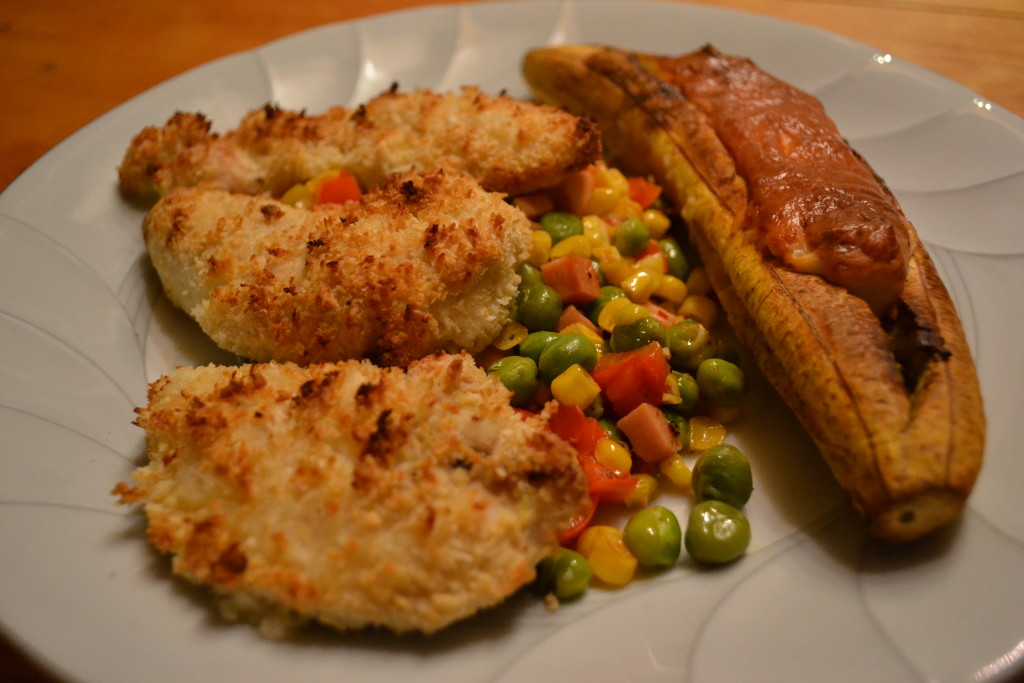On Sunday supplement
Food and Wine
Anyone who spends anytime here discovers quickly that the milanesa, essentially a weiner schnitzel with a touch of Italian heritage, is a staple of both lunch and dinner. There are restaurants devoted just to variations of the dish, from beef to veal to chicken to fish to, now and again, amazingly enough, a vegetable of some sort – soy, squash, eggplant. At its most basic, the clasico, is simply a thin slice of veal or beef that’s been rolled in breadcrumbs and fried until crisp, the center often as tough as shoe leather, and served up on a plate with a wedge or two of lemon.
But there are elaborate versions as well, and one of the ones that caught my eye early on was the suprema maryland – a pounded thin breast of chicken that has likewise been breaded and fried, and served up with some combination of corn and/or peas, cream or bechamel, or not, peppers, ham, bacon, fried egg, and, generally, a fried banana. One has to wonder just where such a concoction came from. There is a history of Chicken Maryland – the two most classic versions are from the state of the same name in the U.S., where it is a dish of fried chicken with a white cream gravy; and, a British version of fried chicken served with a corn fritter and, there, a fried banana.
But there are other versions as well – battered chicken served with ham and hush puppies, the batter generally including sweetcorn mixed in, other versions with fried pineapple rings, and still others with pieces of friend chicken sauteed with sliced bananas. In southeast Asia it’s served with fried tomatoes, carrots, potatoes, and yes, bananas. One thing that all have in common, with the exception of the Argentine version, they are invariably made with chicken thighs and legs.
So what can we do to lighten this dish up and make it a tad healthier? The biggest thing is eliminating all the frying; and the second is taking out the ham or bacon and putting in a lean roast pork loin. I also recommend using panko crumbs rather than regular breadcrumbs – they absorb less oil. And plantains bake up better than bananas. This dish looks potentially complicated, but it’s actually quite easy to put together.
Chicken Maryland
2 chicken breasts, pounded thin and cut in 2-3 cm strips
flour
1 egg
panko crumbs
2 plantains
100 gm melting cheese – mozzarella, danbo, or something similar
1 tablespoon olive oil
100 gm red bell pepper, diced
100 gm corn kernels
100 gm fresh peas
100 gm roasted pork loin, diced
salt, pepper, chili flakes
1 tablespoon olive oil
Turn on your oven to 180°. In a large saute or frying pan warm a tablespoon of oil over low heat. Add the corn, peas, bell pepper and pork. Season lightly with salt, pepper and chili flakes and cook over low heat, stirring occasionally.
While the vegetables are cooking peel the plantains. Oil them with the other tablespoon of olive oil and place on a large baking sheet. Place in the oven and cook for 30 minutes. Meanwhile, dust the chicken strips with salt, pepper and flour. Beat the egg with an equal amount of water. Dip each chicken strip into this and then the panko crumbs (or breadcrumbs). Set aside to dry slightly.
After the 30 minutes, remove the baking sheet. Flip the plantains over onto their other side. Place the chicken strips around the rest of the baking sheet and replace in the oven for 15 minutes. Remove again, slit open the plantains lengthwise, and fill with cheese. Once again into the oven and cook until the cheese is melted and browned (you can use the broiler if you like).
By now the vegetable mixture will be just perfect. Serve all the components together for our updated version of Chicken Maryland.
A series of recipes and articles that I started writing for the Buenos Aires Herald Sunday supplement, Food & Wine section, at the beginning of 2012. My original proposal to them was to take local favorite dishes and classics and lighten them up for modern day sensibilities. We’re not talking spa or diet recipes, but at the very least, making them healthier in content, particularly salt, fat and portion size. As time went by, that morphed into a recipe column that, while emphasizing food that is relatively “good for you”, wasn’t necessarily focused on local cuisine. At the beginning of 2013 I decided to stop writing for them over some administrative issues, but it was fun while it lasted.
